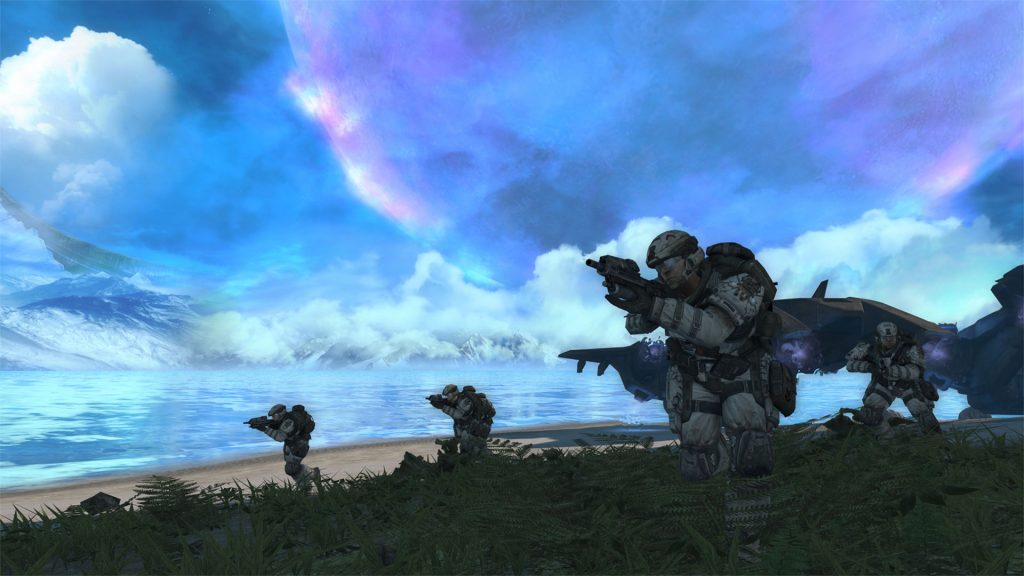Video Gamer is reader-supported. When you buy through links on our site, we may earn an affiliate commission. Prices subject to change. Learn more
I really want to be blown away by today’s graphics. Honestly. I long for that feeling of genuine awe when I walk out into an in-game world for the first time. Or experience a mechanic so amazing it just takes my breath away. I’m not talking about booting up the first level and having a sort of ‘yeah, it looks great’ moment. No, I’m talking about having that rush of excitement – that feeling you get when you know you’ve just made a memory for a lifetime.
The same you had when you first landed on the beach on the The Silent Cartographer level in Halo. Or the Normandy beach landing in Medal of Honor: Frontline (which was arguably not as effective as the PC’s D-Day landing in Medal of Honor: Allied Assault). Psychologists call these ‘flashbulb memories‘, vivid recollections of a specific moment in time, usually associated with the emotional centre of the brain, the amygdala, firing and causing a deeper association.

I know over the past few years I have played some, technically, incredible looking games. It’s hard not to be impressed by the likes of Senua’s Saga: Hellblade 2, with its striking, near photo-realistic visuals. And sure, walking out into Cyberpunk 2077’s Night City with Ray Tracing, and most recently – Path Tracing – enabled certainly looks spectacular. But did it create a memory of a lifetime for me? Not really.
In fact, and call me weird, but no matter how good today’s games look, I have never once managed to have the same wow factor as I did when I first booted up Perfect Dark: Zero on Xbox 360, or stepping out on to Halo’s vast planet after crash landing. I remember being so excited by visuals. In fact, I specifically remember the back of the Halo: Combat Evolved box proudly stating the game boasted ‘hyper-realistic’ graphics. I would spend hours going as close I could to the textures – being amazed that features like tree bark were so detailed. Who else remembers the first time they switched on the Master Chief’s torch and experienced bump mapping for the first time? Today, and I speak really here of AAA games – there is some really stunning art direction coming from the indie scene – nothing has the same effect.
I have never once managed to have the same wow factor as I did when I first booted up Perfect Dark: Zero on Xbox 360.
What’s interesting is that, at least on a technical level, we should be seeing – in my view – similar sorts of jumps we saw between the last-last-gen consoles (I’m talking about the OG Xbox versus the Xbox 360), but instead it just ‘feels’ as though the gap between what makes a game last-gen and ‘next-gen’ has become closer. Take Crysis, for example. When I was younger I used to spend hours building a PC on a retail website, just so it could theoretically play Crysis. I could never have afforded it. It was because its visuals were so far and away from what I thought possible at the time I was so envious of those who got to play it. When I did play it, many, many years later, it was considered an old game. It still blew me away – with one of my favourite ever gaming memories walking up the first hill for the screen to then ‘black bar’ and present a stunning vista of the island.
Another one of my favourites actually takes me back to the PS1 days. Anyone remember Fear Effect? For those who haven’t played this, I absolutely recommend it. Many talk of classics like Syphon Filter and Metal Gear pushing the little grey box to its limits, but how a game like Fear Effect ran on a PS1 continues to baffle me. This is a game that, no joke, actually holds its own today, seamlessly blending in FMV with gameplay. I was, and am still, blown away with how they managed to do this.

Remember, these were days were there wasn’t 24GB of VRAM or DLSS to play with. It’s fascinating and makes you really appreciate it that little bit more when you see how the developers ‘solved for’ these constrained parameters. Look closely at Fear Effect and you’ll see ever-so-slight ‘black screens’ between scenes. It’s basically been stitched together very, very cleverly.
A more recent example is The Order: 1886 – which arrived on the PS4. Panned at the time for its ‘linear’ gameplay, I implore anyone to look at that game today and not be impressed. This is a ‘last gen’ game boasting graphics that really look as good as today’s. What has happened?
Part of the reason I think that games lack that ‘wonder’ anymore is that they all use the same graphical tools and engines to get there. Whether that’s Unreal Engine 4 /5 or other accessible tools, it’s wonderful for accessibility and democratises stunning visuals, but perhaps raises the bar making it harder for a game to really stand out.
Experiences like these – truly, visual-led experiences – are getting fewer and far between. With the news that Sony intends to Prioritize ‘Memorable, Immersive’ experiences over visuals, I fear there is also an industry-wide acknowledgement that perhaps people have become immune to ‘technically impressive’ graphics, which is such a shame. I wonder if this generation of players coming through will ever experience those awe inspiring moments many of us older generation experienced – I certainly hope so.

